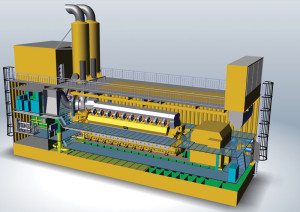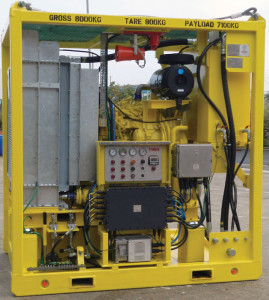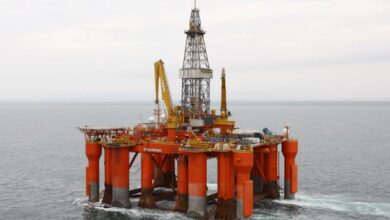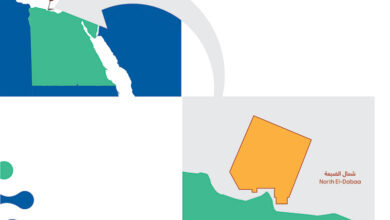FPSO boom calls for care with power supply equipment, hazards
Increased safety focus needed as FPSOs trend toward larger, more potent onboard power generation
By Isaac Fox and Micki Jain, Caterpillar Oil & Gas
Editor’s Note: With this article, DC notes the growing importance of FPSOs to the global E&P market, particularly in deepwater regions such as Brazil and Africa.

The global FPSO market has encountered tremendous growth over the past 20 years and is showing no sign of slowing. Over the past decade, FPSOs have experienced consistent growth at an annual rate of 9.1%. The global fleet is now made up primarily of newbuilds with a minority share of hull conversions. It’s a youthful fleet, with units averaging approximately nine years in age.
This growth in the FPSO market has been aided by technological innovations that are allowing FPSO units to be applicable in more and more deepwater developments. Particularly in Latin America – offshore Brazil – there have already been significant positive impacts from the evolution of F PSO technology.
As a result of the technology advances, FPSO size and capabilities are increasing, therefore requiring larger, more potent power-generation sources, specifically on the topside. Reciprocating engines are now in high demand as a power source for much of the topside equipment, and it is critical to fully understand hazardous locations and related regulations.
Standards, regulations
Like others within the offshore industry, the FPSO segment has placed a significant emphasis on compliance with safety regulations. There has been increased scrutiny of safety practices, both within the industry and by governmental agencies, since Macondo. As the size and overall output of power-generation sources increase, so does the need to accurately and thoroughly account for all hazardous locations on an FPSO unit.
Hazardous areas involving explosive atmospheres due to the presence of gas are divided into zones or divisions based on the potential for explosions in a specific area. For gas, the zones are:
• A safe area: considered a very low risk for an explosion due to the presence of gas. An example of a safe area on an FPSO would be the crew’s quarters.
• Division 2 or Zone 2 area: considered a low risk for an explosion due to the presence of gas. Gas would be present in this area or zone only as an unwanted substance or a result of an abnormality and should be present there fewer than 10 hours a year. An example of this on an FPSO would be the work areas near the crew’s quarters, such as the loading and unloading pad.
• Division 1 or Zone 1 Area: considered a risk for an explosion due to the frequent presence of gas. Gas may be present from about 10 to 10,000 hours in areas of this classification. On an FPSO, these areas would be near the processing equipment.
• Division 1 or Zone 0 area: gas is present in the atmosphere at all times or more than 10,000 hours annually. On an FPSO, this area would be in or near the processing equipment and storage areas.
During the design of an FPSO, when accounting for hazardous locations potentially involving explosive atmospheres due to the presence of gas, two key activities must be completed:
• The classification of areas in terms of the frequency with which gas may be present and the types of gases that may be present.
• Selection of protected equipment for these areas. Equipment should include features to prevent the ignition of hazardous atmospheres, to stifle explosions once they have started, or to prevent an explosive atmosphere from reaching potential sources of ignition.

The classification of hazardous areas is the initial step in properly ensuring a vessel is in compliance with safety standards. Internationally, IEC 60079-10 provides guidance for such classification. Industry standards, such as API RP 500, API RP 505 and EI IP 15, provide guidance for the classification of hazardous areas in petroleum-processing facilities. These standards help to define the hazardous locations in the design phase. Engineers will need to lay out process equipment and storage vessels and subsequently refer to the standards to draw boundaries.
It should be noted that although the location of equipment is determined prior to construction, its precise location can be altered during construction. To facilitate the smooth construction of an FPSO, there should be efforts to ensure that every piece of topside equipment, including equipment for safe areas, is at least suitable for Zone 2 areas.
Upon the classification of hazardous areas, the next step is to select equipment with appropriate protection. Equipment protection is facilitated by standards that provide design guidance and form the basis for equipment certification.
Common hazardous area standards
Standards and directives have historically evolved around the globe as a result of safety incidents, disasters or to address commercial issues. For this discussion, it is imperative to distinguish between regulations and standards. Standards contain design criteria and recommendations, typically based on the experience and collaboration of groups of industry experts. Standards generally do not have the force of law unless given by a separate regulation.
Regulations, or laws, are created by governmental agencies mandating certain equipment be used or certain standards be met in relevant applications for their respective jurisdictions. Examples of government regulatory directives include Explosive Atmospheres (ATEX) in the European Union (EU), the Code of Federal Regulations in the United States and INMETRO technical regulations in Brazil. Local laws establish a minimum level of safety that must be met. Customers and end users may also require that equipment they purchase meet designated standards of their choice, beyond those required by local laws, to improve safety and reduce risk. For power-generation equipment, there are both electrical and non-electrical standards, discussed below, that may be referenced during the design process.
With respect to electrical systems, the International Electrotechnical Commission (IEC) blazed the path for the implementation of shared standards. Formed in 1906 to identify methods to curtail mine and industrial disasters, the IEC creates and publishes standards that are referenced globally for electrical work. Many of its 81 member states adopt or adapt IEC standards as national standards.
It is the authors’ experience that the most commonly referenced set of electrical standards for this equipment is the IEC 60079 series and its derivative standards worldwide, but the US National Electrical Code (NFPA 70) is also influential globally.
The National Fire Protection Association (NFPA) provides consensus codes and standards to reduce the impact of fire and other hazards on quality of life. NFPA 70 is a standard that defines wiring practices for equipment used in hazardous locations and is referenced globally, particularly in the Americas, Africa and the Middle East.
Non-electrical standards are available from several organizations; but the authors believe the most commonly referenced standards for power generation equipment are issued by the European Committee for Standardization (CEN). Commonly referenced standards for mechanical systems within power-generation equipment include:
• EN 1127, which describes basic concepts and methodology for explosion prevention;
• EN 13463, which defines protection methods for non-electrical equipment to be used in classified hazardous areas; and
• EN 1834, which describes safety requirements for reciprocating internal combustion engines in classified/hazardous areas.
ASTM F2876 also provides guidance for combustion engines used in classified areas in offshore environments.
Regulations by region
Government regulations vary significantly by region of operation. For example, in the United States, equipment that is placed in a classified hazardous location on an FPSO must meet the standards set forth in the US National Electric Code (NEC), also known as NFPA 70. Components will typically be certified for use in classified areas (example: Class 1 Division 2), and wiring will be performed per the requirements of NEC 500-516.
US federal laws also mandate that reciprocating engines in these locations have inlet air shut-off valves to prevent overspeed and exhaust spark arrestors to prevent the escape of sparks to the surroundings.
In Latin America, it has been popular in the industry to reference US standards on offshore equipment even though US regulations are not in force. In recent years, some countries have migrated to IEC standards because they allow increased flexibility in the selection of equipment, especially equipment that will be exposed to corrosive atmospheres.
Within Brazil, INMETRO technical regulations define the requirements for equipment used in classified areas. According to INMETRO regulatory standard NR-179, electrical equipment for hazardous locations within Brazil must be certified to the applicable ABNT NBR IEC standards, but there is an exception for offshore equipment installed on vessels during their construction in foreign shipyards. This exception provides some leeway for FPSO builders to select equipment that is certified per the applicable standards in the country of origin. However, equipment that is added or replaced while the vessel is in Brazilian waters must meet Brazilian certification requirements.
The ATEX directives have a different origin than most other safety regulations. Whereas many regulations seek to correct safety deficiencies by mandating adherence to a set of standards, ATEX evolved from a desire to enable the free trade of goods among EU member states and was created to proactively address a market situation. ATEX is split into directives for manufacturers (94/9/EC) and employers (1999/92/EC). The directives require employers with operations in hazardous areas to adhere to minimum requirements to ensure the safety of employees working in a hazardous location. Manufacturers are required to develop proper protection for equipment designed to be used in hazardous areas and introduced to the market within EU member states. ATEX requirements are intended to account for all potential sources of ignition and therefore incorporate protection against both electrical and mechanical (non-electrical) sources.
The ATEX directive applies to products introduced to the market within the EU, but ATEX conformity is often sought for equipment sold or operating outside of the EU due both to the holistic approach of ATEX to equipment protection and familiarity with ATEX requirements among EU-based international companies. Protection against non-electrical sources of ignition is an area where ATEX requirements seem to improve safety compared with the requirements in force in most other areas of the world.
Power supply options
Equipment protection methods vary based on the region in which the FPSO will operate, the area classification and the type of power equipment being utilized. For safety, power-generation equipment will primarily be located in safe areas or Zone 2 areas aboard the vessel. In either case, it may be preferable to protect the equipment as though it were intended for a Zone 2 area, for enhanced safety during emergency situations, to facilitate design changes during the construction phase and to permit the addition or removal of equipment from the FPSO during its service life.
As discussed, complying with the ATEX directive would require protection against electrical and mechanical sources of ignition, whereas the standards for electrical systems (NEC and IEC) do not address mechanical sources of ignition.
Consider the case of a diesel-driven hydraulic power unit protected for use in a Zone 2 area. It is the experience of the authors that a modern diesel engine will have electronic controls and sensors to help ensure safe and reliable operations and low emissions. The engine controls and wiring can be certified for Zone 2 areas if they comply with IEC 60079-series standards for Zone 2, typically by following 60079-14 and a combination of 60079-15 and 60079-11 for different circuits on the engine. The application of these standards would protect against ignition due to arcing or sparking by the engine electrical system, but additional ignition risks remain.
EN 1834-1 describes methods of protecting against these common risks, as does ASTM F2876. Unless specially equipped, the exhaust system components of a diesel engine will have very high surface temperatures, sometimes in excess of 600°C. These temperatures can be mitigated through the use of water-cooled manifolds and turbochargers or, in some cases, through the application of special gas-tight insulation.
The exhaust gas itself may be in excess of 400°C, but this temperature can be reduced below 200°C if an exhaust gas cooler is used. If an explosive atmosphere is present when a diesel engine is running, the atmosphere may find sources of ignition within the intake system of the engine, and so the intake system should have a flame trap installed, and the components should be capable of withstanding an internal explosion if the intake draws from a Zone 2 area.
If the engine ingests combustible material via the inlet air system, the engine may accelerate suddenly to unsafe speed, resulting in failure of the engine or driven equipment and potentially creating sparks or other ignition sources during this failure. To prevent such overspeed events, the engine should be equipped with an inlet air shut-off valve actuated when the engine speed exceeds a predetermined threshold. If the engine is started while an explosive atmosphere is present, gas in the exhaust system may be ignited.
The exhaust system should also be protected against flame transmission and should be capable of withstanding an internal explosion if it connects to a Zone 2 area.
Radiator-cooled engines will present ignition risks at the fan and fan drive, which can be mitigated through a combination of non-sparking materials, static-dissipative belts and appropriate clearances. Engine-starting systems may also present ignition risks, so pre-engaged starters are typically required, and sometimes special pinion materials are used.
These mechanical systems ignition risks are largely unaddressed by the IEC and NEC electrical protection standards and are only sometimes addressed in a regulatory fashion as seen in 30 CFR 250.405. In the absence of regulatory requirements, those parties responsible for the selection of equipment may still insist that the equipment be designed in compliance with additional protective standards, such as EN 1834 or ASTM F2876. Those responsible for equipment selection should weigh the increased cost of protecting against mechanical ignition risks against the potential outcomes if that protection is not in place.
Protection for power generation equipment
Crane power units may be equipped with hazardous area wiring and mechanical system protective equipment whether they are in Zone 2 or in safe areas. It is sometimes possible to reduce the hazardous area classification of the crane power unit by elevating it above the deck such that it is no longer within a classified area or it is in an area with reduced frequency of exposure to explosive mixtures.
Fire pumps may be driven mechanically and by a diesel-electric drive configuration. They will commonly be arranged in a redundant configuration and placed in safe areas to the extent possible. It is common for each to have its own respective power and fuel supply, lighting, ventilation and control valves. Even though a fire pump engine may be located within a safe area, safety can be improved by using hazardous area wiring and protective equipment on these engines.
Smaller generator sets can be effectively protected for Zone 2 areas through selection of an appropriate generator, application of suitable wiring practices and electrical components, and the installation of flame traps, exhaust gas coolers, air shut-off valves and anti-static fan drives. This approach is well suited to temporary equipment or equipment that is occasionally relocated, including those that are brought onboard during maintenance and repairs. Gas detection and automatic shutdown systems mounted on temporary equipment are also gaining popularity because of their increased safety and operating flexibility.
Larger generator sets permanently installed on the vessel topside may be protected by installing them within pressurized rooms (per IEC 60079-13) that draw air from and reject exhaust to safe areas.
This approach is not ideal for temporary equipment, as finding safe areas for intake and exhaust ducts can be difficult, and pressurized containers may be damaged during transport, thereby preventing successful pressurization when reinstalled. This approach does allow the use of more conventional and less expensive engines, generators, switches, breakers and wiring. Generator set modules are available from various manufacturers that include built-in provisions for protection of the module from explosion risk.
It is desirable that emergency gen-sets be allowed to continue operating in conditions where a shutdown of the main power-generation systems is required. To enable safe operation of the emergency generator sets under such conditions, they can be protected as for Zone 2 areas even when they are located in safe areas. This protection would include hazardous area electrical and electronic components and a suitable set of protective equipment for the engine based on the relevant regulatory requirements and customer-specified standards.
Conclusion
FPSO designers and architects need to understand hazardous locations, regulations and equipment protection standards to effectively specify equipment for FPSOs. Various standards are in use around the world, some of which are enforced by law and some that are voluntary.
Individuals with responsibility for equipment selection should consider whether to apply standards beyond the minimum requirements of local laws, considering both risk mitigation and future operating flexibility as markets and regulatory requirements shift. The benefits of discretionary safety measures may outweigh the cost of increased protection in many cases.




